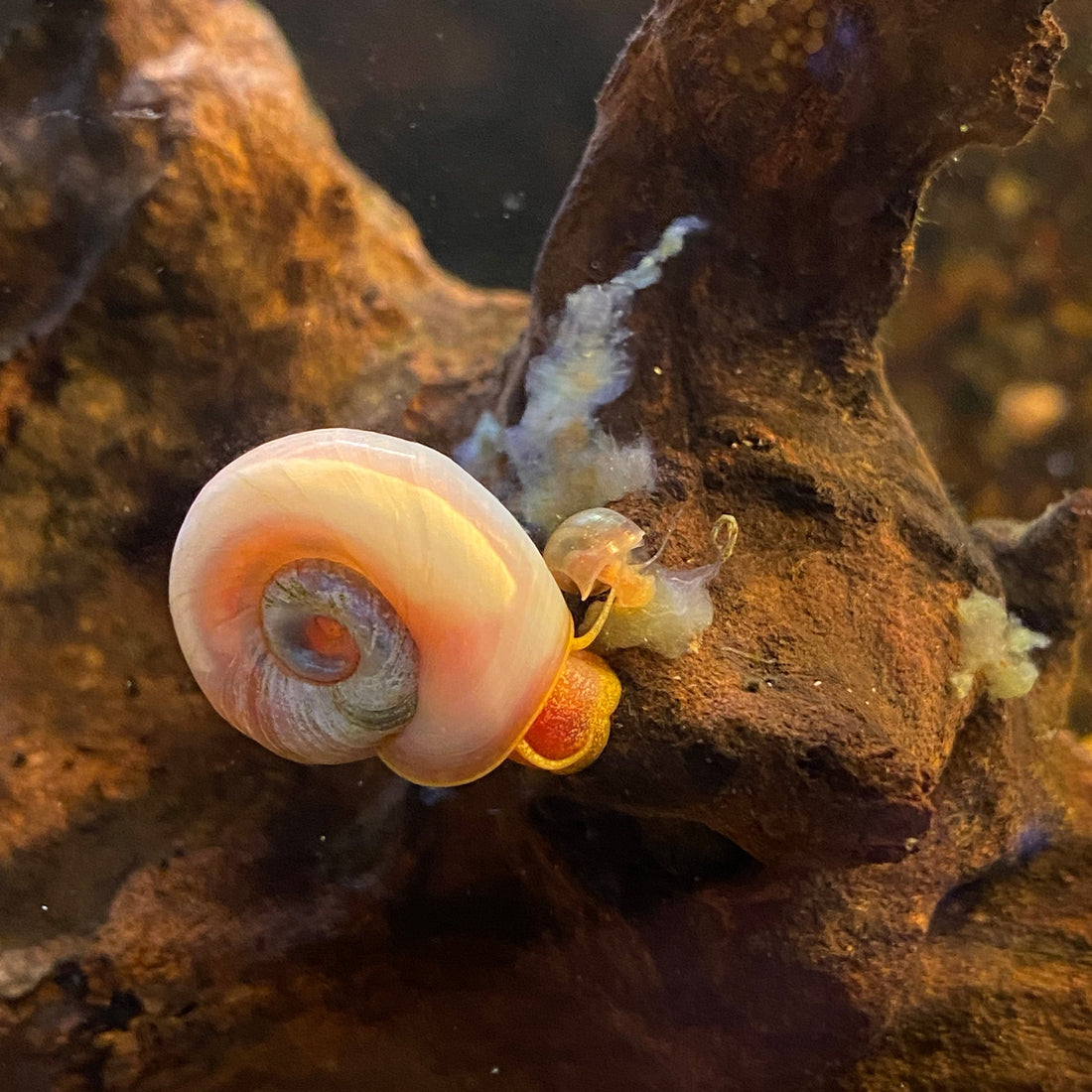
Ramshorn Snail Care Guide: Tank Setup, Diet, and Population Contro
Share
Ramshorn snails are popular freshwater aquarium snails known for their unique spiral shells and algae-eating habits. These low-maintenance invertebrates help keep your tank clean by consuming leftover food, decaying plants, and algae.
However, Ramshorn snails reproduce quickly, making population control essential. In this guide, we’ll cover Ramshorn snail care, tank setup, diet, breeding, and tips for preventing overpopulation.
Why Keep Ramshorn Snails in Your Aquarium?
Ramshorn snails are often kept in aquariums for their natural cleaning abilities and low-maintenance care. Here’s why they make great tank additions:
✅ Algae Eaters: They help control algae growth on glass, plants, and decorations.
✅ Leftover Food Cleanup: They eat excess fish food, reducing waste and ammonia buildup.
✅ Great for Planted Tanks: They consume decaying plant matter without harming healthy plants.
✅ Low Maintenance: They thrive in a variety of conditions, making them ideal for beginners.
However, Ramshorn snails multiply quickly, so if left unchecked, they can overpopulate your tank.
Ramshorn Snail Tank Setup & Water Parameters
Ideal Tank Size for Ramshorn Snails
- Suitable for tanks 5 gallons or larger
- Best kept in 10+ gallon tanks to prevent overpopulation
Water Parameters
- Temperature: 65–82°F (18–28°C)
- pH: 7.0–8.0 (Avoid acidic water to prevent shell erosion)
- Water Hardness: Moderate to high (Calcium is essential for shell health)
- Ammonia/Nitrites: 0 ppm (Stable, cycled water is necessary)
Best Substrate & Decorations
- Substrate: Fine gravel or sand for easy foraging
- Plants: Java moss, Anubias, and Hornwort provide hiding spots and food
- Filtration: Use a sponge filter or low-flow filter to prevent harm to snails
💡 Tip: Adding a cuttlebone or crushed eggshells to the tank provides extra calcium, ensuring strong, healthy shells.
What Do Ramshorn Snails Eat?
Ramshorn snails are omnivores and will eat a variety of foods, including:
🟢 Algae – Natural algae from tank surfaces (a major part of their diet)
🟢 Leftover Fish Food – Flakes, pellets, sinking wafers
🟢 Blanched Vegetables – Zucchini, spinach, lettuce
🟢 Decaying Plant Matter – Helps keep tanks clean
🟢 Calcium-Rich Foods – Cuttlebone, crushed eggshells, or specialty snail food
🚨 Warning: If their shells appear thin, cracked, or transparent, it means they lack calcium and need supplementation.
Ramshorn Snail Breeding & How to Control Population Growth
How Fast Do Ramshorn Snails Reproduce?
Ramshorn snails are hermaphrodites, meaning any two snails can breed. They lay egg clusters on plants, glass, and decorations. In optimal conditions, their numbers can increase rapidly, leading to overpopulation.
How to Prevent a Ramshorn Snail Infestation
🐌 Limit Overfeeding: Less leftover food means fewer snails.
🐌 Manual Removal: Remove egg clusters and excess snails regularly.
🐌 Introduce Predators: Fish like Bettas, Loaches, or Assassin Snails eat Ramshorn snails.
🐌 Control Water Conditions: Keeping a stable, clean tank discourages excessive breeding.
💡 Tip: If you want to keep your Ramshorn snails without overpopulation, maintain a balanced ecosystem with natural predators and controlled feeding.
Common Ramshorn Snail Health Issues
Even though Ramshorn snails are hardy, they can experience health problems in poor conditions.
Shell Deterioration & Cracks
🔹 Cause: Low calcium levels or acidic water
🔹 Solution: Add calcium-rich food, cuttlebone, or crushed eggshells
Parasitic Infections
🔹 Cause: Wild-caught snails may carry parasites
🔹 Solution: Quarantine new snails before adding them to your tank
Overpopulation & Waste Buildup
🔹 Cause: Too many snails can lead to excess waste
🔹 Solution: Reduce food supply and remove excess snails manually
🚨 Warning: A sudden die-off of snails can cause ammonia spikes, harming fish. Always monitor water quality if snail populations decline rapidly.
Are Ramshorn Snails Right for Your Aquarium?
✅ Great for:
✔️ Freshwater aquariums looking for a natural algae eater
✔️ Aquarists who need low-maintenance snails
✔️ Tanks with live plants that need cleanup helpers
❌ Not ideal for:
❌ Small tanks without predators (they reproduce too fast)
❌ Tanks with soft water (lack of calcium weakens shells)
Final Verdict: Ramshorn snails are fantastic cleanup crew members but require population control to prevent overbreeding. With proper care, they can thrive and benefit your aquarium.
FAQs About Ramshorn Snail Care
🔹 Do Ramshorn snails eat algae?
Yes! They actively graze on soft algae, helping keep tanks clean.
🔹 Will Ramshorn snails eat live plants?
Generally, no. They only eat decaying or dying plants unless food is scarce.
🔹 How long do Ramshorn snails live?
They typically live 1–2 years but can live longer in ideal conditions.
🔹 Do Ramshorn snails need a filter?
Yes, a gentle filter (like a sponge filter) helps maintain water quality.
🔹 Can you keep Ramshorn snails with Betta fish?
Yes! Betta fish usually ignore them, though some may nip at snails.
Final Thoughts
Ramshorn snails are an excellent addition to freshwater tanks, offering natural algae control and tank cleanup. However, their rapid reproduction means you need a population control strategy to avoid overpopulation.
By maintaining proper tank conditions, offering a balanced diet, and monitoring their numbers, you can keep your Ramshorn snails healthy, thriving, and beneficial to your aquarium.
